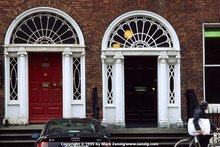
Some people don't expect the temperate climate Ireland has. They think it is cold and snowy. But Ireland is warmed by the Gulf Stream and nowhere in Ireland is more than 90 kilometres from the sea, so Ireland's climate is fairly oceanic over most of the country. Ireland is well known for its changeability. Ireland has a lot of rain, but it is normally drizzle, so it is rarely heavy. Places in the west can receive more than 2000 mm of rain a year. While places in the east can receive at least 700mm of rain.
Even due to its northerly latitude, snow in Ireland is infrequent (except on mountains) and is rarely heavy. But Ireland can have at least 1 or 2 snow days in a year. One example is the 3-4th of January 2008, when over a foot of snow fell in just 6 hours which is unusual. Also, a rare type of phenomenon known a "Thundersnow" (which means a thunderstorm with snow falling instead of rain) was seen in some parts of Northern Ireland and North Leinster.
Temperatures in Ireland do not vary that much. Temperatures in January normally vary between 4 and 7 degrees. In July, temperatures normally vary between 14 and 16 degrees. In winter, temperatures can fall to 0 or below on some cold days, but normally fall to -5 on nights and occassionally down to -10.
In Summer temperatures can exceed to 20 and even 25. Temperatures of 30 are rare but not unheard. In July 2006, a temperature of 32.3 was recorded in the midlands. Here are records of temperatures in Ireland:
Even due to its northerly latitude, snow in Ireland is infrequent (except on mountains) and is rarely heavy. But Ireland can have at least 1 or 2 snow days in a year. One example is the 3-4th of January 2008, when over a foot of snow fell in just 6 hours which is unusual. Also, a rare type of phenomenon known a "Thundersnow" (which means a thunderstorm with snow falling instead of rain) was seen in some parts of Northern Ireland and North Leinster.
Temperatures in Ireland do not vary that much. Temperatures in January normally vary between 4 and 7 degrees. In July, temperatures normally vary between 14 and 16 degrees. In winter, temperatures can fall to 0 or below on some cold days, but normally fall to -5 on nights and occassionally down to -10.
In Summer temperatures can exceed to 20 and even 25. Temperatures of 30 are rare but not unheard. In July 2006, a temperature of 32.3 was recorded in the midlands. Here are records of temperatures in Ireland:
- Highest temperature: 33.3 degrees
- Lowest temperature: -19.1 degrees
Sometimes strong winds can affect Ireland. In January 2007, the European Windstorm Kyrill affected Ireland severely with winds battering of up to 149 kilometres per hour at Dublin. An even stronger wind affected Ireland in the year 1839. It is known as Ireland's 2nd worst natural disaster. It is known in Ireland as the Night of the Big Wind. It swept across Ireland on the night of January 6/7. Winds battered at up to 205 kilometres per hour. A quarter of all Dublin houses suffered damage or were completely destroyed. Large amounts of flooding were reported. Severe poverty was caused by it. In Irish folklore, it was known as Judgement Day. It was the worst storm to hit Ireland for many centuries.




